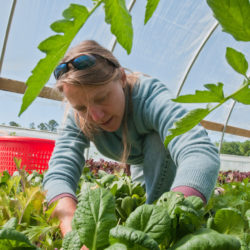
How the Supply Chain of Our Food Is Becoming More Transparent

What is the future of food?
I’m sure many of us truly believed as children that by this point in time we’d be eating cubes instead of food, as technology and mankind would have advanced to the point where we’d all be living on the moon.
Obviously we are not quite there yet, but our food processes are undergoing incredible changes as technology brings in new innovations.
As we become more conscious and aware of the potential and possibilities found in technology innovators are uncovering ways to use it to change our relationship to food.
After all, in the grand tradition of “knowledge is power and ignorance is bliss” concept, modern consumers are now more knowledgeable about the politics that control their food and want to know what their food went through before it got to their table.
Given how blockchain is everywhere it shouldn’t be surprising to learn that the technology has a role to play when it comes to solving this issue.
Want to know everything about your food, from who farmed it to what’s in it to the route it took to the grocery store? Ripe.io and its “Blockchain of Food” can give you the answer.
The recent E-Coli outbreaks show how important this knowledge is and can be. Being able to track which product came from which farm is vital when trying to prevent (more) consumers from buying and eating tainted produce.
Provenance is another company offering blockchain tracking, aiming to ensure an item labelled organic lives up to its name. The company knows the power in this information and stresses its potential to both businesses and consumers.
You should know what went into your food. It’s good to see technology is helping us learn.
Waste management and our global footprint are rising in importance as our population grows and our resources shrink. With continuing water crises occurring across the globe Canada and the United States stand as some of the biggest wasters on the planet, with roughly 40% of our food ending up in the trash. We need a solution.
Technology is gearing up to help.
A major issue, of course, is fruits and vegetables spoiling before people can eat it. Imagine how great it would be if your produce lasted longer. Apeel Sciences is working on the solution.
By simply adapting the peel Apeel has given produce a new, longer lifespan, in turn increasing its shelf life.
Goodr is also aiming to limit waste, but in a different way. Its app connects restaurants and businesses to non-profits in order to ensure unused food is given a purpose. So far it has rerouted 1 million lbs of food, feeding the hungry while simultaneously reducing carbon emissions.
These initiatives are amazing and incredibly needed. Let’s hope they get embraced by the market.
Another very important factor to consider when looking into the footprint (and quality) of your food is how far it went to get to your plate. Buy Local is becoming a rallying cry of many environmentally-conscious foodies.
But in many places Buy Local is easier said than done. If you are entirely reliant on what your local grocery store offers you can only buy what their contracts allow them to sell.
Luckily there are entrepreneurs who know the importance of Buy Local and are working to make this easier to do.
BrightFarms, for example, is using greenhouses and hydroponics in order to provide fresh local food year-round to customers. Currently operating greenhouses in Illinois, Ohio, Pennsylvania and Virginia, the company’s goal is to expand its services and offer greenhouses near other major hubs, in turn increasing consumers’ access to fresh and nutritious produce year-round.
This is definitely an initiative we should all be getting behind.
Modern technology is increasing our access to fresh food and our knowledge of the path our food took to get to our plate while also reducing the amount of waste we create. All of this is delicious news and shows the positive impact we can make when we use technology properly.
The future of food is promising (and not limiting us to food in pill form).

